Caries Status in People with Dementia: A Systematic Review
Abstract
1. Introduction
2. Materials and Methods
2.1. Search Strategy
2.2. Inclusion and Exclusion Criteria
2.3. Study Screening and Data Extraction
2.4. Quality Assessment
2.5. Statistical Analysis
3. Results
3.1. Included Studies
3.2. Main Characteristics of the Included Studies
3.3. Quality Assessment of the Included Studies
3.4. Meta-Analysis
3.4.1. DMFT Index
3.4.2. DT Index
3.4.3. MT Index
3.4.4. FT Index
3.4.5. CDT, CFT, CDS, CDFS, RDS and RDFS Indexes
3.5. Subgroup Analysis
4. Discussion
5. Conclusions
Supplementary Materials
Author Contributions
Funding
Institutional Review Board Statement
Informed Consent Statement
Data Availability Statement
Conflicts of Interest
List of Abbreviations
| AD | Alzheimer disease; |
| AMT | Abbreviated mental test; |
| CDR | The Clinical Dementia Rating score; |
| CDT | Coronal decayed teeth; |
| CDS | Coronal decayed surfaces; |
| CDFS | Coronal decayed and filled surfaces; |
| CFT | Coronal filled teeth; |
| DMFT | Decayed(D), Missing(M), Filled(F) Teeth; |
| DSM-IV | Diagnostic and statistical manual of mental disorders, fourth edition; |
| DSM-IV-TR | Diagnostic and statistical manual of mental disorders, fourth edition, text revision; |
| ICD-10 | International Classification of Diseases, Tenth Revision; |
| MMSE | Mini-mental State Examination; |
| NINCDS-ADRDA | National Institute of Neurological and Communicative Disorders and Stroke and the Alzheimer’s Disease and Related Disorders Association; |
| RDS | Root decayed surfaces; |
| RDFS | Root decayed and filled surfaces; |
| shorten MMSE | A shortened version of the Mini Mental State Examination. |
References
- WHO. International Classification of Disease. Available online: https://icd.who.int/browse11/lm/en#/http%3a%2f%2fid.who.int%2ficd%2fentity%2f546689346 (accessed on 16 June 2024).
- Lane, C.A.; Hardy, J.; Schott, J.M. Alzheimer’s disease. Eur. J. Neurol. 2018, 25, 59–70. [Google Scholar] [CrossRef] [PubMed]
- Feast, A.; Orrell, M.; Charlesworth, G.; Melunsky, N.; Poland, F.; Moniz-Cook, E. Behavioural and psychological symptoms in dementia and the challenges for family carers: Systematic review. Br. J. Psychiatry 2016, 208, 429–434. [Google Scholar] [CrossRef] [PubMed]
- Tisher, A.; Salardini, A. A Comprehensive Update on Treatment of Dementia. Semin. Neurol. 2019, 39, 167–178. [Google Scholar] [CrossRef] [PubMed]
- ADI. World Alzheimer Report. 2023. Available online: https://www.alzint.org/u/World-Alzheimer-Report-2023.pdf (accessed on 16 June 2024).
- Gale, S.A.; Acar, D.; Daffner, K.R. Dementia. Am. J. Med. 2018, 131, 1161–1169. [Google Scholar] [CrossRef]
- Zalewska, A.; Klimiuk, A.; Zięba, S.; Wnorowska, O.; Rusak, M.; Waszkiewicz, N.; Szarmach, I.; Dzierżanowski, K.; Maciejczyk, M. Salivary gland dysfunction and salivary redox imbalance in patients with Alzheimer’s disease. Sci. Rep. 2021, 11, 23904. [Google Scholar] [CrossRef]
- Selwitz, R.H.; Ismail, A.I.; Pitts, N.B. Dental caries. Lancet 2007, 369, 51–59. [Google Scholar] [CrossRef]
- Ship, J.A. Oral health of patients with Alzheimer’s disease. J. Am. Dent. Assoc. 1992, 123, 53–58. [Google Scholar] [CrossRef]
- Auerbacher, M.; Gebetsberger, L.; Kaisarly, D.; Schmidmaier, R.; Hickel, R.; Drey, M. Oral health in patients with neurodegenerative and cerebrovascular disease: A retrospective study. Disabil. Rehabil. 2022, 45, 2316–2324. [Google Scholar] [CrossRef]
- Panzarella, V.; Mauceri, R.; Baschi, R.; Maniscalco, L.; Campisi, G.; Monastero, R. Oral Health Status in Subjects with Amnestic Mild Cognitive Impairment and Alzheimer’s Disease: Data from the Zabút Aging Project. J. Alzheimer’s Dis. 2022, 87, 173–183. [Google Scholar] [CrossRef]
- Adam, H.; Preston, A.J. The oral health of individuals with dementia in nursing homes. Gerodontology 2006, 23, 99–105. [Google Scholar] [CrossRef]
- Hatipoglu, M.G.; Kabay, S.C.; Güven, G. The clinical evaluation of the oral status in Alzheimer-type dementia patients. Gerodontology 2011, 28, 302–306. [Google Scholar] [CrossRef] [PubMed]
- Zeng, X.; Zhang, Y.; Kwong, J.S.; Zhang, C.; Li, S.; Sun, F.; Niu, Y.; Du, L. The methodological quality assessment tools for preclinical and clinical studies, systematic review and meta-analysis, and clinical practice guideline: A systematic review. J. Evid. Based Med. 2015, 8, 2–10. [Google Scholar] [CrossRef] [PubMed]
- Moola, S.; Munn, Z.; Tufanaru, C.; Aromataris, E.; Sears, K.; Sfetc, R.; Currie, M.; Lisy, K.; Qureshi, R.; Mattis, P.; et al. Systematic reviews of etiology and risk. In JBI Manual for Evidence Synthesis, 2024th ed.; Aromataris, E., Lockwood, C., Porritt, K., Pilla, B., Jordan, Z., Eds.; JBI, 2020; Available online: https://synthesismanual.jbi.global (accessed on 16 June 2024). [CrossRef]
- Cebeci, I.A.; Ozturk, D.; Dogan, B.; Bekiroglu, N. Assessment of Oral Health in Elders with and without Alzheimer’s Disease: A Cross-Sectional Study. Clin. Exp. Health Sci. 2021, 11, 849–855. [Google Scholar] [CrossRef]
- Gu, W.; Li, J.; Li, F.; Ho, T.E.; Feng, X.; Wang, Y.; Fan, M.; Cui, M.; Xu, K.; Chen, X.; et al. Association between oral health and cognitive function among Chinese older adults: The Taizhou imaging study. BMC Oral Health 2023, 23, 640. [Google Scholar] [CrossRef]
- Chalmers, J.M.; Carter, K.D.; Spencer, A.J. Caries incidence and increments in community-living older adults with and without dementia. Gerodontology 2002, 19, 80–94. [Google Scholar] [CrossRef]
- Yang, Y.; Liang, L.; Cai, J.; You, J.; Liao, X. Improving oral hygiene for better cognitive health: Interrelationships of oral hygiene habits, oral health status, and cognitive function in older adults. J. Adv. Nurs. 2024, 80, 275–286. [Google Scholar] [CrossRef]
- Kim, K.S.; Ahn, S.; Han, J.W.; Cho, S.H.; Lee, J.T.; Lee, H.J.; Kim, K.W. Oral health and risk of cognitive disorders in older adults: A biannual longitudinal follow-up cohort. J. Oral Rehabil. 2023, 50, 792–801. [Google Scholar] [CrossRef]
- Ribeiro, G.R.; Costa, J.L.; Ambrosano, G.M.; Garcia, R.C. Oral health of the elderly with Alzheimer’s disease. Oral Surg. Oral Med. Oral Pathol. Oral Radiol. 2012, 114, 338–343. [Google Scholar] [CrossRef]
- Wu, Y.F.; Lee, W.F.; Salamanca, E.; Yao, W.L.; Su, J.N.; Wang, S.Y.; Hu, C.J.; Chang, W.J. Oral Microbiota Changes in Elderly Patients, an Indicator of Alzheimer’s Disease. Int. J. Environ. Res. Public Health 2021, 18, 4211. [Google Scholar] [CrossRef]
- van de Rijt, L.J.; Feast, A.R.; Vickerstaff, V.; Lobbezoo, F.; Sampson, E.L. Prevalence and associations of orofacial pain and oral health factors in nursing home residents with and without dementia. Age Ageing 2020, 49, 418–424. [Google Scholar] [CrossRef]
- Syrjälä, A.M.; Ylöstalo, P.; Ruoppi, P.; Komulainen, K.; Hartikainen, S.; Sulkava, R.; Knuuttila, M. Dementia and oral health among subjects aged 75 years or older. Gerodontology 2012, 29, 36–42. [Google Scholar] [CrossRef] [PubMed]
- Warren, J.J.; Chalmers, J.M.; Levy, S.M.; Blanco, V.L.; Ettinger, R.L. Oral health of persons with and without dementia attending a geriatric clinic. Spec. Care Dentist. 1997, 17, 47–53. [Google Scholar] [CrossRef] [PubMed]
- Andersson, P.; Kragh Ekstam, A. Impaired Oral Health in Older Orthopaedic In-Care Patients: The Influence of Medication and Morbidity. Clin. Interv. Aging 2021, 16, 1691–1702. [Google Scholar] [CrossRef] [PubMed]
- Laugisch, O.; Johnen, A.; Buergin, W.; Eick, S.; Ehmke, B.; Duning, T.; Sculean, A. Oral and Periodontal Health in Patients with Alzheimer’s Disease and Other Forms of Dementia—A Cross-sectional Pilot Study. Oral Health Prev. Dent. 2021, 19, 255–261. [Google Scholar] [CrossRef] [PubMed]
- Tiisanoja, A.; Syrjälä, A.M.; Tertsonen, M.; Komulainen, K.; Pesonen, P.; Knuuttila, M.; Hartikainen, S.; Ylöstalo, P. Oral diseases and inflammatory burden and Alzheimer’s disease among subjects aged 75 years or older. Spec. Care Dentist. 2019, 39, 158–165. [Google Scholar] [CrossRef]
- Arrivé, E.; Letenneur, L.; Matharan, F.; Laporte, C.; Helmer, C.; Barberger-Gateau, P.; Miquel, J.L.; Dartigues, J.F. Oral health condition of French elderly and risk of dementia: A longitudinal cohort study. Community Dent. Oral Epidemiol. 2012, 40, 230–238. [Google Scholar] [CrossRef]
- Kossioni, A.E.; Kossionis, G.E.; Polychronopoulou, A. Oral health status of elderly hospitalised psychiatric patients. Gerodontology 2012, 29, 272–283. [Google Scholar] [CrossRef]
- Campos, C.H.; Ribeiro, G.R.; Rodrigues Garcia, R.C. Oral health-related quality of life in mild Alzheimer: Patient versus caregiver perceptions. Spec. Care Dentist. 2016, 36, 271–276. [Google Scholar] [CrossRef]
- Bramanti, E.; Bramanti, A.; Matacena, G.; Bramanti, P.; Rizzi, A.; Cicciù, M. Clinical evaluation of the oral health status in vascular-type dementia patients:a case-control study. Minerva Stomatol. 2015, 64, 167–175. [Google Scholar]
- D’Alessandro, G.; Costi, T.; Alkhamis, N.; Bagattoni, S.; Sadotti, A.; Piana, G. Oral Health Status in Alzheimer’s Disease Patients: A Descriptive Study in an Italian Population. J. Contemp. Dent. Pract. 2018, 19, 483–489. [Google Scholar] [CrossRef]
- Ellefsen, B.; Holm-Pedersen, P.; Morse, D.E.; Schroll, M.; Andersen, B.B.; Waldemar, G. Caries prevalence in older persons with and without dementia. J. Am. Geriatr. Soc. 2008, 56, 59–67. [Google Scholar] [CrossRef] [PubMed]
- Philip, P.; Rogers, C.; Kruger, E.; Tennant, M. Caries experience of institutionalized elderly and its association with dementia and functional status. Int. J. Dent. Hyg. 2012, 10, 122–127. [Google Scholar] [CrossRef] [PubMed]
- Chen, X.; Clark, J.J.; Naorungroj, S. Oral health in nursing home residents with different cognitive statuses. Gerodontology 2013, 30, 49–60. [Google Scholar] [CrossRef] [PubMed]
- Jockusch, J.; Hopfenmüller, W.; Nitschke, I. Influence of cognitive impairment and dementia on oral health and the utilization of dental services: Findings of the Oral Health, Bite force and Dementia Study (OrBiD). BMC Oral Health 2021, 21, 399. [Google Scholar] [CrossRef]
- Hopcraft, M.S.; Morgan, M.V.; Satur, J.G.; Wright, F.A. Edentulism and dental caries in Victorian nursing homes. Gerodontology 2012, 29, e512–e519. [Google Scholar] [CrossRef]
- Gao, S.S.; Chen, K.J.; Duangthip, D.; Lo, E.C.M.; Chu, C.H. The Oral Health Status of Chinese Elderly People with and without Dementia: A Cross-Sectional Study. Int. J. Environ. Res. Public Health 2020, 17, 1913. [Google Scholar] [CrossRef]
- Syrjälä, A.M.; Ylöstalo, P.; Sulkava, R.; Knuuttila, M. Relationship between cognitive impairment and oral health: Results of the Health 2000 Health Examination Survey in Finland. Acta Odontol. Scand. 2007, 65, 103–108. [Google Scholar] [CrossRef]
- Aragón, F.; Zea-Sevilla, M.A.; Montero, J.; Sancho, P.; Corral, R.; Tejedor, C.; Frades-Payo, B.; Paredes-Gallardo, V.; Albaladejo, A. Oral health in Alzheimer’s disease: A multicenter case-control study. Clin. Oral Investig. 2018, 22, 3061–3070. [Google Scholar] [CrossRef]
- Cestari, J.A.F.; Fabri, G.M.C.; Kalil, J.; Nitrini, R.; Jacob, W.; de Siqueira, J.T.T.; Siqueira, S. Oral Infections and Cytokine Levels in Patients with Alzheimer’s Disease and Mild Cognitive Impairment Compared with Controls. J. Alzheimer’s Dis. 2016, 52, 1479–1485. [Google Scholar] [CrossRef]
- Chu, C.H.; Ng, A.; Chau, A.M.; Lo, E.C. Oral health status of elderly chinese with dementia in Hong Kong. Oral Health Prev. Dent. 2015, 13, 51–57. [Google Scholar] [CrossRef]
- Jones, J.A.; Lavallee, N.; Alman, J.; Sinclair, C.; Garcia, R.I. Caries incidence in patients with dementia. Gerodontology 1993, 10, 76–82. [Google Scholar] [CrossRef] [PubMed]
- McKhann, G.M.; Knopman, D.S.; Chertkow, H.; Hyman, B.T.; Jack, C.R., Jr.; Kawas, C.H.; Klunk, W.E.; Koroshetz, W.J.; Manly, J.J.; Mayeux, R.; et al. The diagnosis of dementia due to Alzheimer’s disease: Recommendations from the National Institute on Aging-Alzheimer’s Association workgroups on diagnostic guidelines for Alzheimer’s disease. Alzheimer’s Dement. 2011, 7, 263–269. [Google Scholar] [CrossRef] [PubMed]
- Kidd, E.; Fejerskov, O. Changing concepts in cariology: Forty years on. Dent. Update 2013, 40, 277–286. [Google Scholar] [CrossRef] [PubMed]
- Delwel, S.; Binnekade, T.T.; Perez, R.S.G.M.; Hertogh, C.M.P.M.; Scherder, E.J.A.; Lobbezoo, F. Oral hygiene and oral health in older people with dementia: A comprehensive review with focus on oral soft tissues. Clin. Oral Investig. 2018, 22, 93–108. [Google Scholar] [CrossRef]
- Rejnefelt, I.; Andersson, P.; Renvert, S. Oral health status in individuals with dementia living in special facilities. Int. J. Dent. Hyg. 2006, 4, 67–71. [Google Scholar] [CrossRef]
- Noble, J.M.; Scarmeas, N.; Papapanou, P.N. Poor oral health as a chronic, potentially modifiable dementia risk factor: Review of the literature topical collection on dementia. Curr. Neurol. Neurosci. Rep. 2013, 13, 384. [Google Scholar] [CrossRef]
- Delwel, S.; Binnekade, T.T.; Perez, R.S.; Hertogh, C.M.; Scherder, E.J.; Lobbezoo, F. Oral health and orofacial pain in older people with dementia: A systematic review with focus on dental hard tissues. Clin. Oral Investig. 2017, 21, 17–32. [Google Scholar] [CrossRef]
- Zeng, L.N.; Zong, Q.Q.; Xu, S.W.; An, F.R.; Ungvari, G.S.; Bressington, D.T.; Cheung, T.; Qin, M.Z.; Chen, L.G.; Xiang, Y.T. Oral health in patients with dementia: A meta-analysis of comparative and observational studies. Int. J. Geriatr. Psychiatry 2021, 36, 467–478. [Google Scholar] [CrossRef]
- Hamza, S.A.; Asif, S.; Bokhari, S.A.H. Oral health of individuals with dementia and Alzheimer’s disease: A review. J. Indian Soc. Periodontol. 2021, 25, 96–101. [Google Scholar] [CrossRef]
- Cicciù, M.; Matacena, G.; Signorino, F.; Brugaletta, A.; Cicciù, A.; Bramanti, E. Relationship between oral health and its impact on the quality life of Alzheimer’s disease patients: A supportive care trial. Int. J. Clin. Exp. Med. 2013, 6, 766–772. [Google Scholar]
- Gil-Montoya, J.A.; Sánchez-Lara, I.; Carnero-Pardo, C.; Fornieles-Rubio, F.; Montes, J.; Barrios, R.; Gonzalez-Moles, M.A.; Bravo, M. Oral Hygiene in the Elderly with Different Degrees of Cognitive Impairment and Dementia. J. Am. Geriatr. Soc. 2017, 65, 642–647. [Google Scholar] [CrossRef] [PubMed]
- Sumi, Y.; Ozawa, N.; Michiwaki, Y.; Washimi, Y.; Toba, K. Oral conditions and oral management approaches in mild dementia patients. Nihon Ronen Igakkai Zasshi 2012, 49, 90–98. [Google Scholar] [CrossRef] [PubMed][Green Version]
- Fujihara, I.; Sadamori, S.; Abekura, H.; Akagawa, Y. Relationship between behavioral and psychological symptoms of dementia and oral health status in the elderly with vascular dementia. Gerodontology 2013, 30, 157–161. [Google Scholar] [CrossRef] [PubMed]
- Ho, B.V.; Weijenberg, R.A.F.; van der Maarel-Wierink, C.D.; Visscher, C.M.; van der Putten, G.J.; Scherder, E.J.A.; Lobbezoo, F. Effectiveness of the implementation project ’Don’t forget the mouth!’ of community dwelling older people with dementia: A prospective longitudinal single-blind multicentre study protocol (DFTM!). BMC Oral Health 2019, 19, 91. [Google Scholar] [CrossRef]
- Curtis, S.A.; Scambler, S.; Manthorpe, J.; Samsi, K.; Rooney, Y.M.; Gallagher, J.E. Everyday experiences of people living with dementia and their carers relating to oral health and dental care. Dementia 2021, 20, 1925–1939. [Google Scholar] [CrossRef]
- Lauritano, D.; Moreo, G.; Carinci, F.; Borgia, R.; Lucchese, A.; Contaldo, M.; Della Vella, F.; Bernardelli, P.; Moreo, G.; Petruzzi, M. Aging and Oral Care: An Observational Study of Characteristics and Prevalence of Oral Diseases in an Italian Cohort. Int. J. Environ. Res. Public Health 2019, 16, 3763. [Google Scholar] [CrossRef]
- Jockusch, J.; Riese, F.; Theill, N.; Sobotta, B.A.J.; Nitschke, I. Aspects of oral health and dementia among Swiss nursing home residents. Z. Gerontol. Geriatr. 2021, 54, 500–506. [Google Scholar] [CrossRef]
- Hegde, M.N.; Attavar, S.H.; Shetty, N.; Hegde, N.D.; Hegde, N.N. Saliva as a biomarker for dental caries: A systematic review. J. Conserv. Dent. 2019, 22, 2–6. [Google Scholar] [CrossRef]
- Barbe, A.G. Medication-Induced Xerostomia and Hyposalivation in the Elderly: Culprits, Complications, and Management. Drugs Aging 2018, 35, 877–885. [Google Scholar] [CrossRef]
- Gil-Montoya, J.A.; Barrios, R.; Sánchez-Lara, I.; Carnero-Pardo, C.; Fornieles-Rubio, F.; Montes, J.; Gonzalez-Moles, M.A.; Bravo, M. Prevalence of Drug-Induced Xerostomia in Older Adults with Cognitive Impairment or Dementia: An Observational Study. Drugs Aging 2016, 33, 611–618. [Google Scholar] [CrossRef]
- Ship, J.A.; DeCarli, C.; Friedland, R.P.; Baum, B.J. Diminished submandibular salivary flow in dementia of the Alzheimer type. J. Gerontol. 1990, 45, M61–M66. [Google Scholar] [CrossRef] [PubMed]
- Friedlander, A.H.; Norman, D.C.; Mahler, M.E.; Norman, K.M.; Yagiela, J.A. Alzheimer’s disease: Psychopathology, medical management and dental implications. J. Am. Dent. Assoc. 2006, 137, 1240–1251. [Google Scholar] [CrossRef] [PubMed]
- Smith, E.E. Clinical presentations and epidemiology of vascular dementia. Clin. Sci. 2017, 131, 1059–1068. [Google Scholar] [CrossRef] [PubMed]
- Larmas, M. Has dental caries prevalence some connection with caries index values in adults? Caries Res. 2010, 44, 81–84. [Google Scholar] [CrossRef]
- Shulman, J.D.; Cappelli, D.P. Chapter 1—Epidemiology of Dental Caries. In Prevention in Clinical Oral Health Care; Cappelli, D.P., Mobley, C.C., Eds.; Mosby: Saint Louis, MO, USA, 2008; pp. 2–13. [Google Scholar] [CrossRef]
- Becker, T.; Levin, L.; Shochat, T.; Einy, S. How much does the DMFT index underestimate the need for restorative care? J. Dent. Educ. 2007, 71, 677–681. [Google Scholar] [CrossRef]
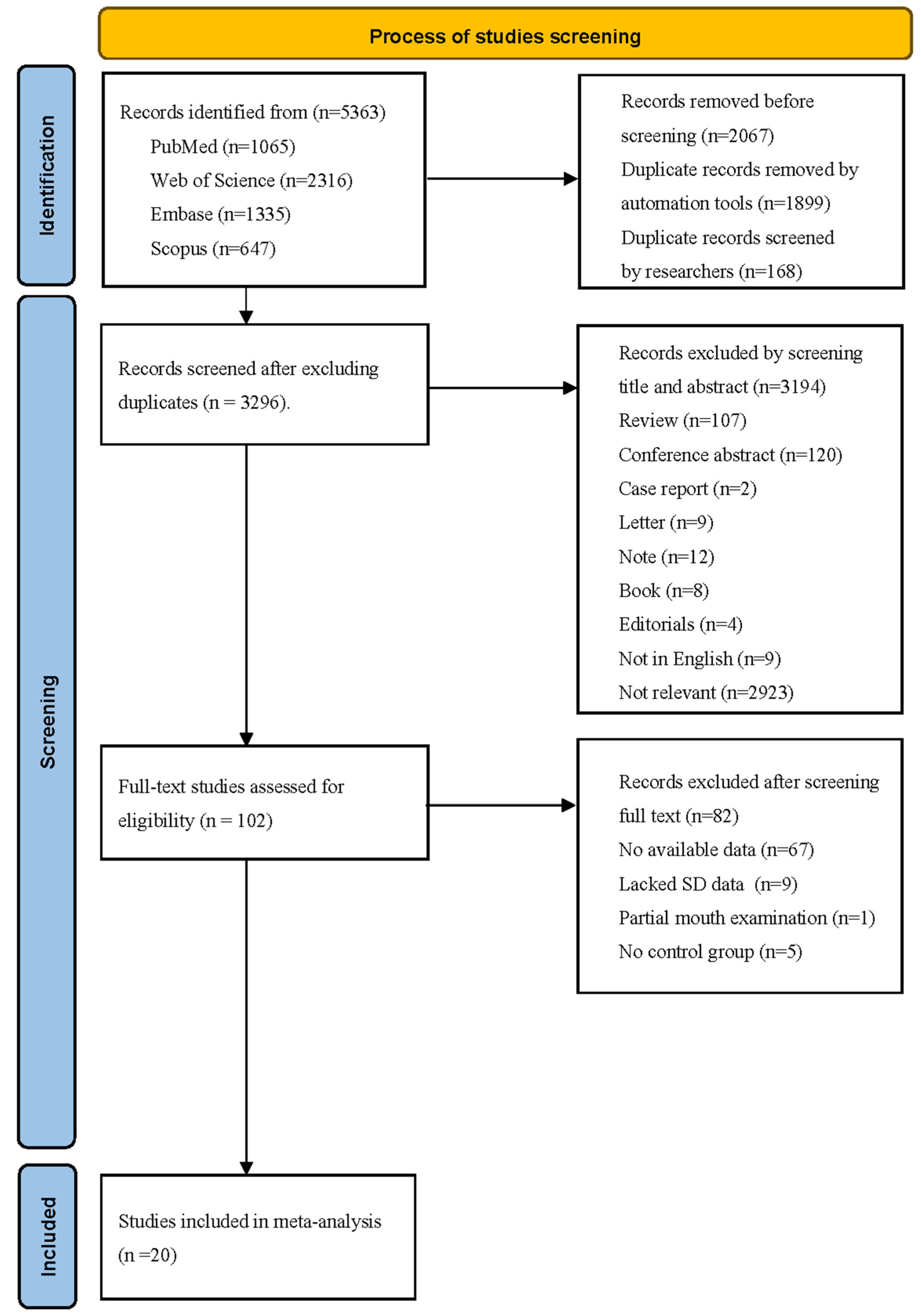
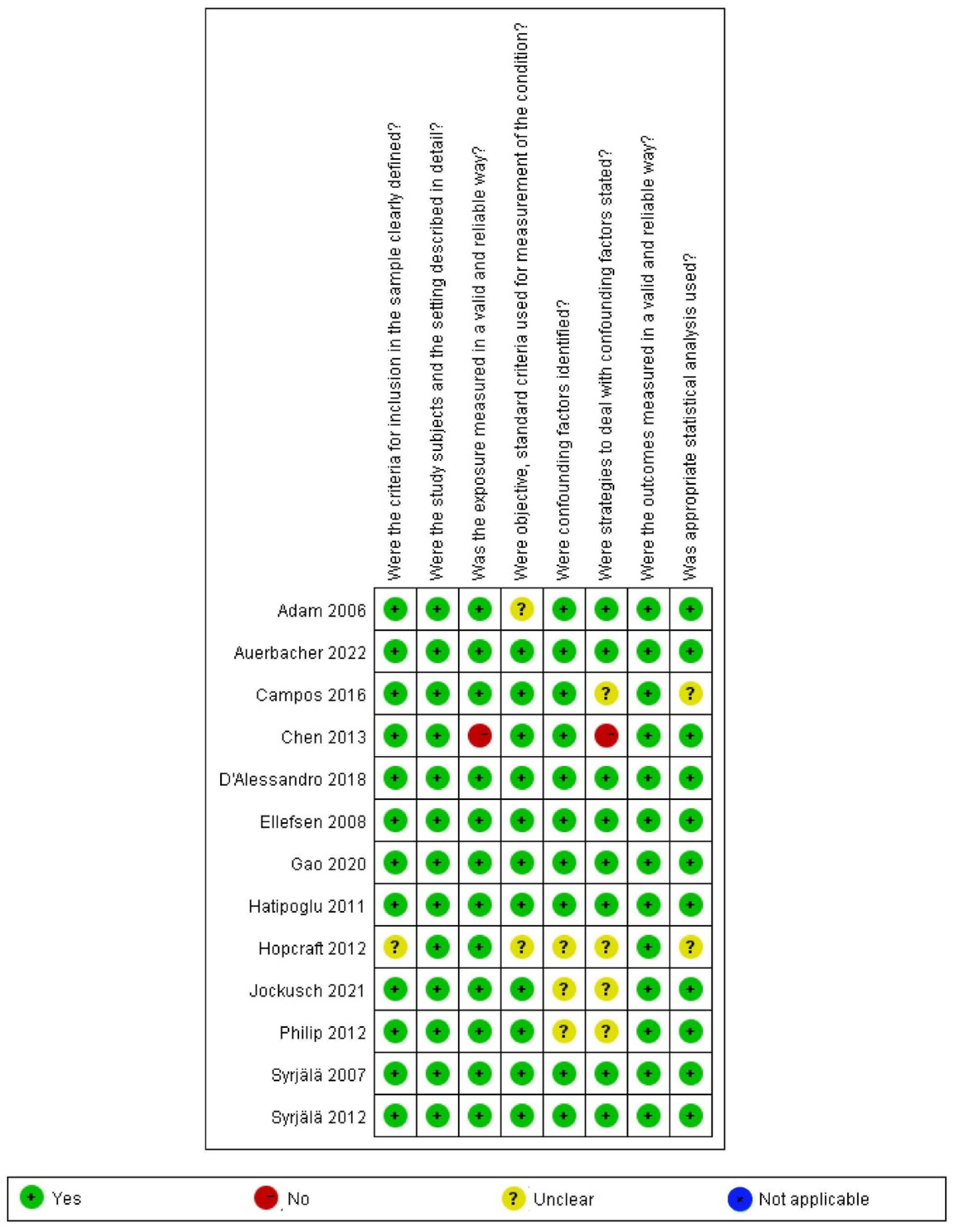
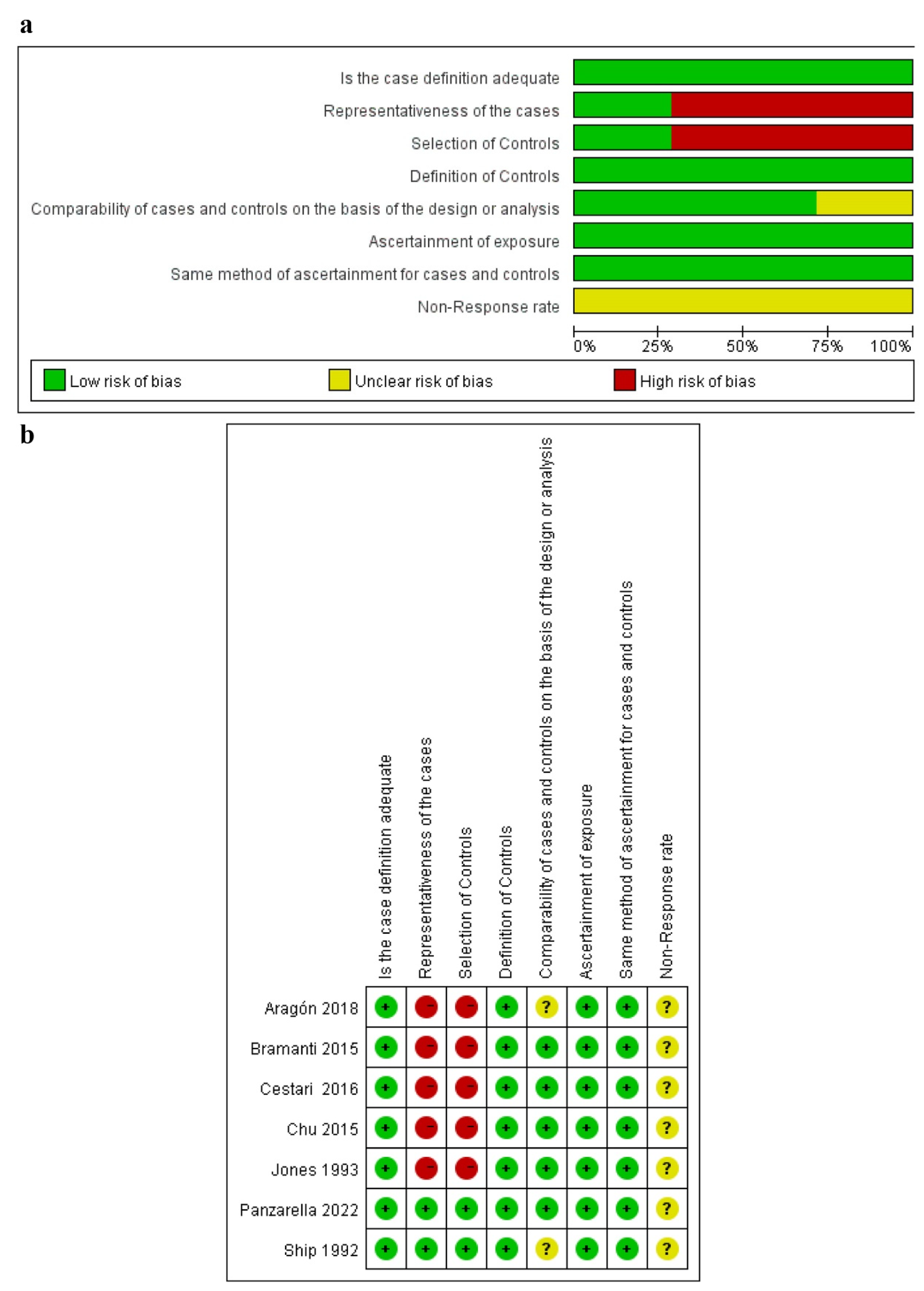
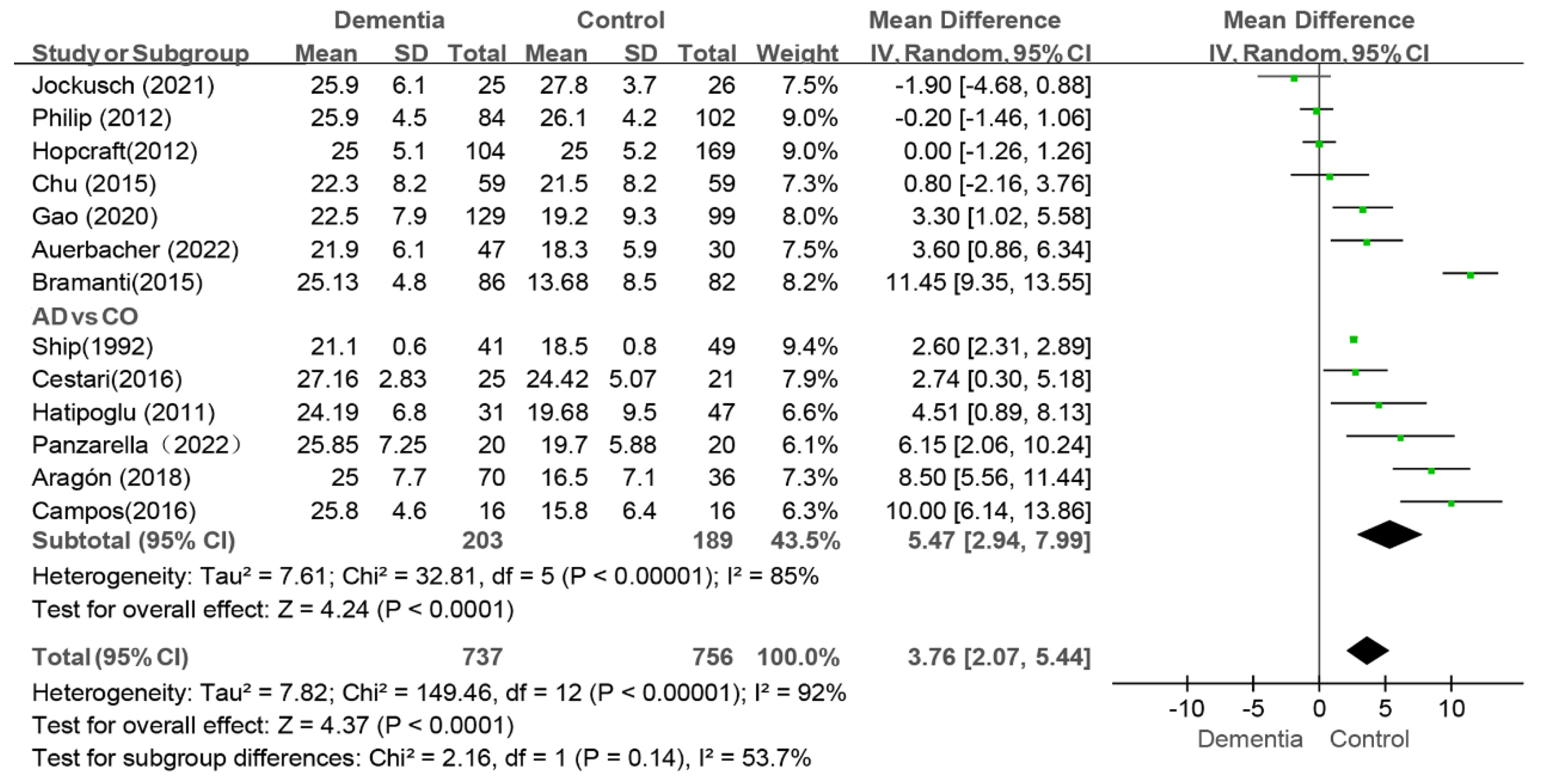
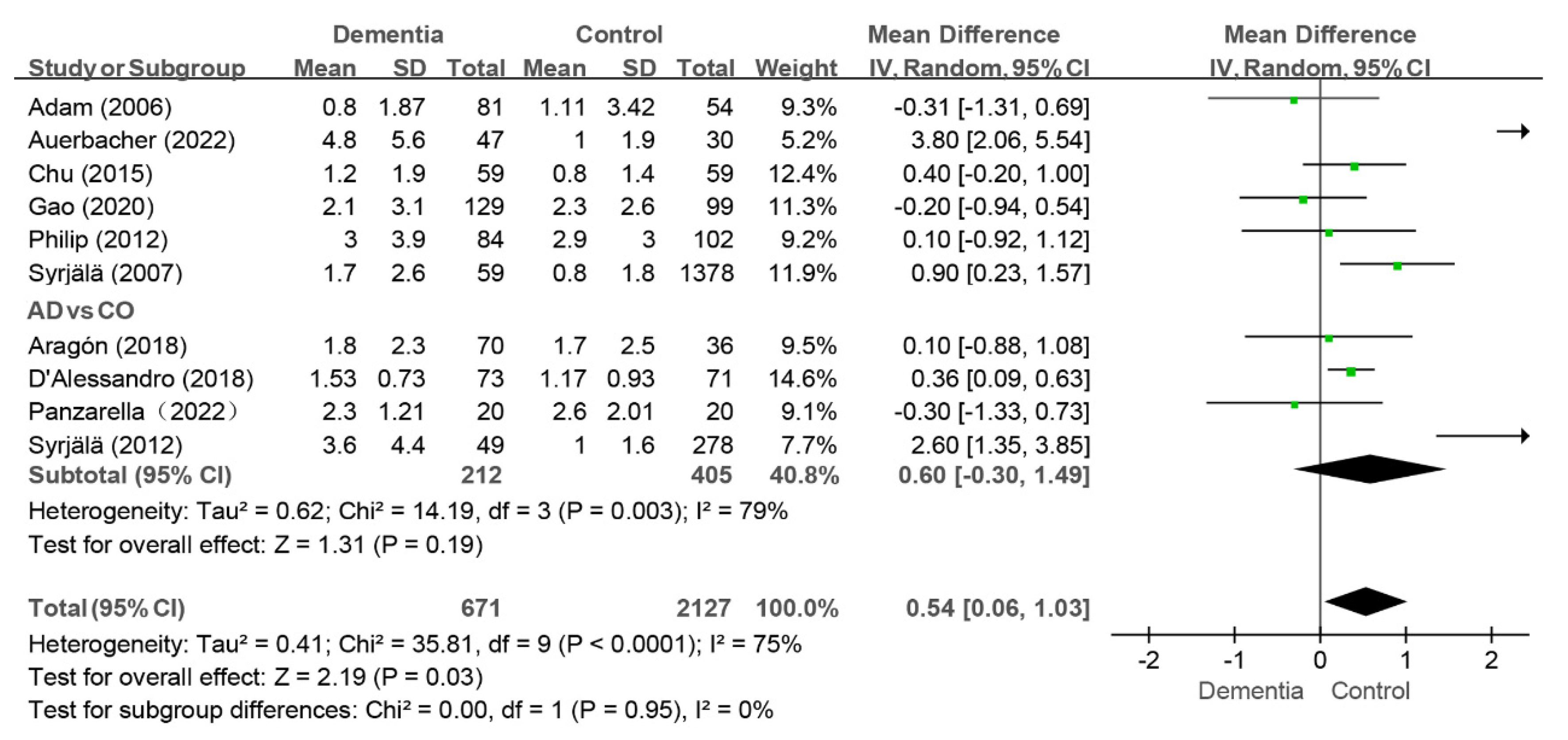

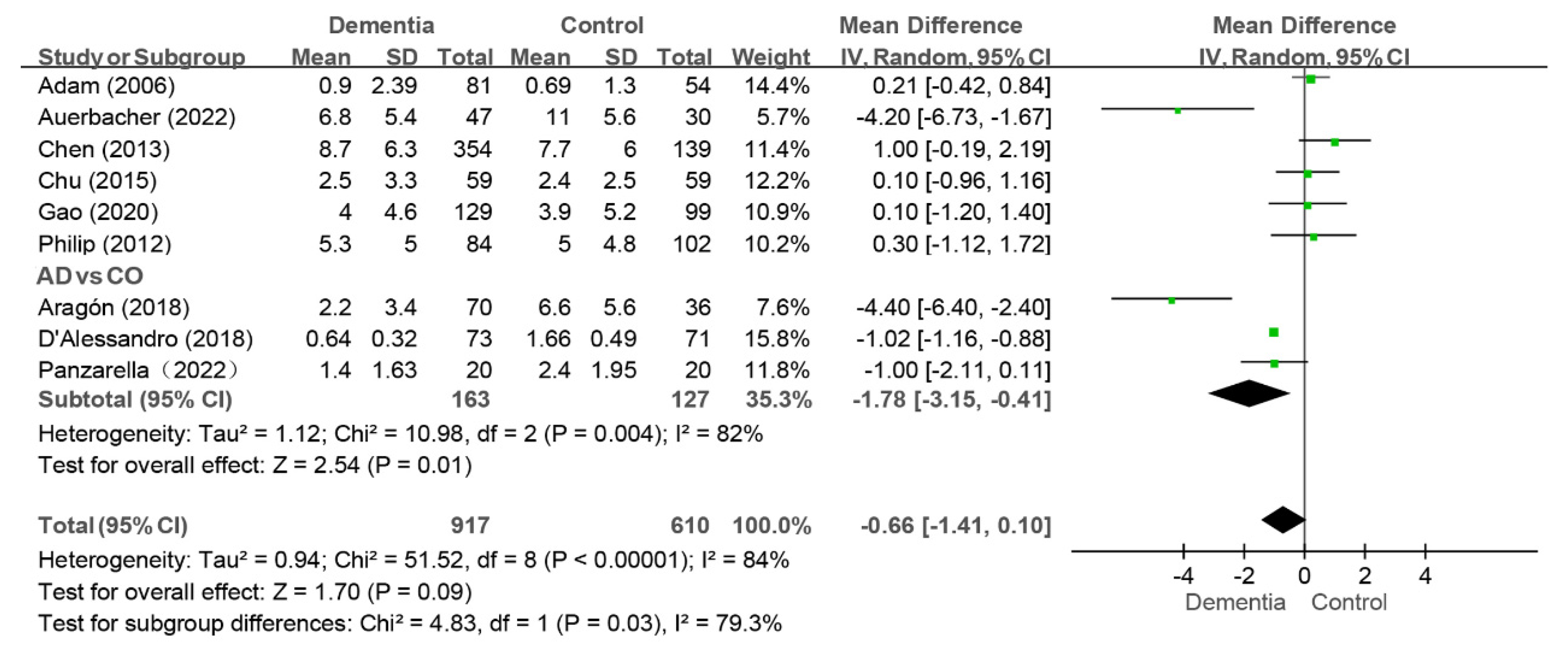
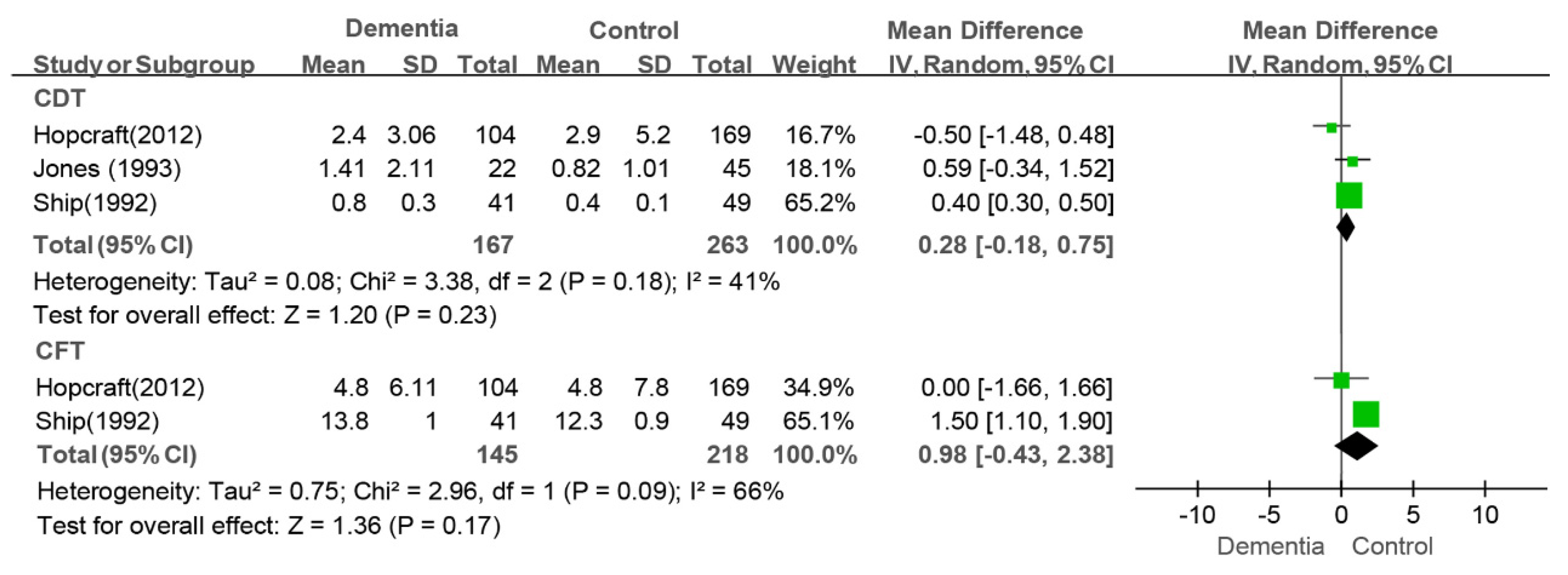
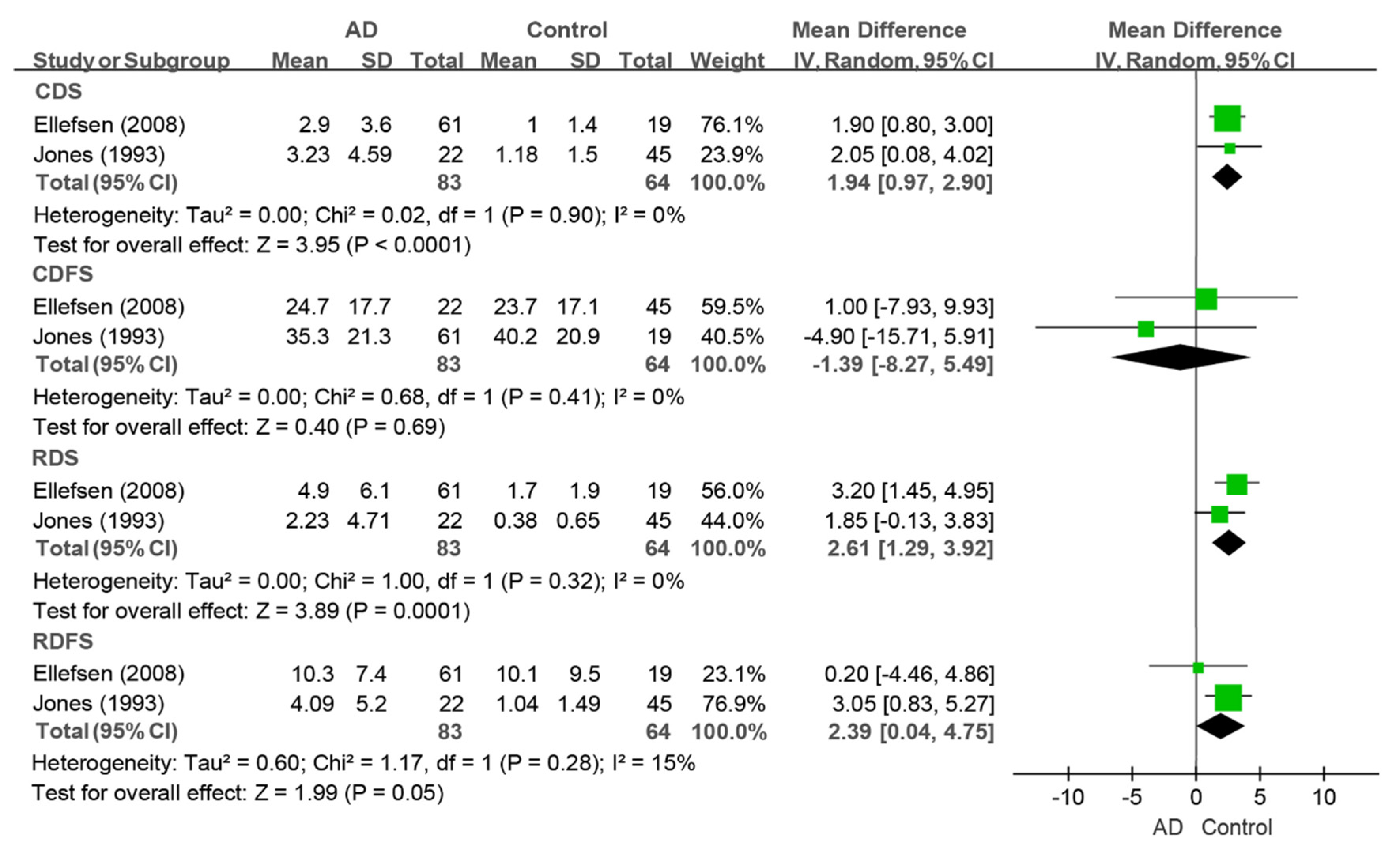
| Studies | Location | Study Design | Mean Age | Mean Age | Dementia | Caries Indexes |
|---|---|---|---|---|---|---|
| First Author (Year) | (Dementia) | (Control) | Measurement | |||
| Adam (2006) [12] | UK | cross- sectional | 80.78 | 85.48 | AMT | DT/MT/FT |
| Aragón (2018) [41] | German | case–control | 77.4 | 62.6 | McKhann et al. [45] diagnosed criteria | DMFT/DT/MT/FT |
| Auerbacher (2022) [10] | German | cross- sectional | 76.7 | 61.5 | medical records | DMFT/DT/MT/FT |
| Bramanti (2015) [32] | Italy | case–control | 82.7 | 80.2 | MMSE | DMFT |
| Campos (2016) [31] | Brazil | cross- sectional | 76.7 | 51.7 | ICD-10 | DMFT |
| Cestari (2016) [42] | Brazil | case–control | 77.68 | 75.33 | NINCDS-ADRDA | DMFT |
| Chen (2013) [36] | USA | cross- sectional | 82.6 | 76.1 | medical records | FT |
| Chu (2015) [43] | China | case–control | 79.8 | unclear | unclear | DMFT/DT/MT/FT |
| D’Alessandro (2018) [33] | Italy | cross- sectional | 79.1 | 77.68 | CDR | DT/FT |
| Ellefsen (2008) [34] | Denmark | cross- sectional | 82.4 | 79.8 | ICD-10 | CDS/CDFS/RDS/RDFS |
| Gao (2020) [39] | China | cross- sectional | 80.9 | 79.4 | unclear | DMFT/DT/MT/FT |
| Hatipoglu (2011) [13] | Turkey | cross- sectional | 67.61 | 65.32 | MMSE | DMFT |
| Hopcraft (2012) [38] | Australia | cross- sectional | unclear | unclear | medical records | DMFT/CDT/CMT/CFT |
| Jockusch (2021) [37] | Switzerland | cross- sectional | 87 | 75 | MMSE | DMFT |
| Jones (1993) [44] | USA | case–control | 67.4 | 66.1 | unclear | CDT/CDS/CDFS/RDS/RDFS |
| Panzarella (2022) [11] | Italy | case–control | 83.5 | 78.8 | DSM-IV-TR | DMFT/DT/MT/FT |
| Philip (2012) [35] | Australia | cross- sectional | 85.7 | 84.3 | medical records | DMFT/DT/MT/FT |
| Ship (1992) [9] | USA | case–control | 68.2 | 64.1 | NINCDS-ADRDA | DMFT/CDT/CFT |
| Syrjälä (2007) [40] | Finland | cross- sectional | 76.3 | 66.4 | shorten MMSE | DT |
| Syrjälä (2012) [24] | Finland | cross- sectional | 84.8 | 81.4 | DSM-IV | DT |
| Study | Dementia | Control | p Value | |||
|---|---|---|---|---|---|---|
| Mean ± SD | N | Mean ± SD | N | MD | ||
| DMFT | ||||||
| Auerbacher (2022) [10] | 21.9 ± 6.1 | 47 | 18.3 ± 5.9 | 30 | 3.6 | <0.05 |
| Aragón (2018) [41] | 25 ± 7.7 | 70 | 16.5 ± 7.1 | 36 | 8.5 | <0.001 |
| Bramanti (2015) [32] | 25.13 ± 4.8 | 86 | 13.68 ± 8.5 | 82 | 11.45 | <0.05 |
| Campos (2016) [31] | 25.8 ± 4.6 | 16 | 15.8 ± 6.4 | 16 | 10 | unclear |
| Cestari (2016) [42] | 27.16 ± 5.83 | 25 | 24.42 ± 5.07 | 21 | 2.74 | unclear |
| Chu (2015) [43] | 22.3 ± 8.2 | 59 | 21.5 ± 8.2 | 59 | 0.8 | 0.59 |
| Gao (2020) [39] | 22.5 ± 7.9 | 129 | 19.2 ± 9.3 | 99 | 3.3 | 0.041 |
| Hatipoglu (2011) [13] | 24.19 ± 6.8 | 31 | 19.68 ± 9.50 | 47 | 4.51 | 0.126 |
| Hopcraft (2012) [38] | 25 ± 5.1 | 104 | 25 ± 5.2 | 169 | 0 | >0.05 |
| Jockusch (2021) [37] | 25.9 ± 6.1 | 25 | 27.8 ± 3.7 | 26 | −1.9 | >0.05 |
| Panzarella (2022) [11] | 25.85 ± 7.25 | 20 | 19.70 ± 5.88 | 20 | 5.88 | 0.001 |
| Philip (2012) [35] | 25.9 ± 4.5 | 84 | 26.1 ± 4.2 | 102 | −0.2 | >0.05 |
| Ship (1992) [9] | 21.1 ± 0.6 | 41 | 18.5 ± 0.8 | 49 | 2.6 | 0.02 |
| DT | ||||||
| Adam (2006) [12] | 0.80 ± 1.87 | 81 | 1.11 ± 3.42 | 54 | −0.31 | >0.05 |
| Aragón (2018) [41] | 1.8 ± 2.3 | 70 | 1.7 ± 2.5 | 36 | 0.1 | 0.77 |
| Auerbacher (2022) [10] | 4.8 ± 5.6 | 47 | 1.0 ± 1.9 | 30 | 3.8 | unclear |
| Chu (2015) [43] | 1.2 ± 1.9 | 59 | 0.8 ± 1.4 | 59 | 0.4 | 0.28 |
| D’Alessandro (2018) [33] | 1.53 ± 0.73 | 73 | 1.17 ± 0.93 | 71 | 0.36 | 0.005 |
| Gao (2020) [39] | 2.1 ± 3.1 | 129 | 2.3 ± 2.6 | 99 | −0.2 | 0.997 |
| Panzarella (2022) [11] | 2.3 ± 1.21 | 20 | 2.60 ± 2.01 | 20 | −0.3 | >0.05 |
| Philip (2012) [35] | 3 ± 3.9 | 84 | 2.9 ± 3.0 | 102 | 0.1 | >0.05 |
| Syrjälä (2007) [40] | 1.7 ± 2.6 | 59 | 0.8 ± 1.8 | 1378 | 0.9 | 0.04 |
| Syrjälä (2012) [24] | 3.6 ± 4.4 | 49 | 1.0 ± 1.6 | 278 | 2.6 | unclear |
| MT | ||||||
| Adam (2006) [12] | 27.28 ± 7.73 | 81 | 28.22 ± 6.64 | 54 | −0.94 | >0.05 |
| Aragón (2018) [41] | 21.0 ± 10.4 | 70 | 8.3 ± 6.5 | 36 | 12.7 | <0.001 |
| Auerbacher (2022) [10] | 10.3 ± 7.7 | 47 | 6.4 ± 7.8 | 30 | 3.9 | unclear |
| Chu (2015) [43] | 18.9 ± 9.4 | 59 | 18.3 ± 8.9 | 59 | 0.6 | 0.75 |
| Gao (2020) [39] | 16.5 ± 9.5 | 129 | 13.0 ± 9.2 | 99 | 3.5 | 0.528 |
| Panzarella (2022) [11] | 22.05 ± 7.09 | 20 | 14.70 ± 5.75 | 20 | 7.35 | <0.001 |
| Philip (2012) [35] | 17.4 ± 7.3 | 84 | 18.0 ± 7.1 | 102 | −0.6 | >0.05 |
| FT | ||||||
| Adam (2006) [12] | 0.9 ± 2.39 | 81 | 0.69 ± 1.30 | 54 | 0.21 | >0.05 |
| Aragón (2018) [41] | 2.2 ± 3.4 | 70 | 6.6 ± 5.6 | 36 | −4.4 | <0.001 |
| Auerbacher (2022) [10] | 6.8 ± 5.4 | 47 | 11.0 ± 5.6 | 30 | −4.2 | unclear |
| Chen (2013) [36] | 8.7 ± 6.3 | 354 | 7.7 ± 6.0 | 139 | 1 | >0.05 |
| Chu (2015) [43] | 2.5 ± 3.3 | 59 | 2.4 ± 2.5 | 59 | 0.1 | 0.88 |
| D’Alessandro (2018) [33] | 0.64 ± 0.32 | 73 | 1.66 ± 0.49 | 71 | −1.02 | <0.001 |
| Gao (2020) [39] | 4 ± 4.6 | 129 | 3.9 ± 5.2 | 99 | 0.1 | 0.677 |
| Panzarella (2022) [11] | 1.40 ± 1.63 | 20 | 2.40 ± 1.95 | 20 | −1 | >0.05 |
| Philip (2012) [35] | 5.3 ± 5.0 | 84 | 5.0 ± 4.8 | 102 | 0.3 | >0.05 |
| CDT | ||||||
| Jones (1993) [44] | 1.41 ± 2.11 | 22 | 0.82 ± 1.01 | 45 | 0.59 | 0.23 |
| Hopcraft (2012) [38] | 2.4 ± 3.06 | 104 | 2.9 ± 5.2 | 169 | −0.5 | >0.05 |
| Ship (1992) [9] | 0.8 ± 0.3 | 41 | 0.4 ± 0.1 | 49 | 0.4 | >0.05 |
| CDS | ||||||
| Ellefsen (2008) [34] | 2.9 ± 3.9 | 87 | 1.0 ± 1.4 | 19 | 1.9 | >0.05 |
| Jones (1993) [44] | 3.23 ± 4.59 | 22 | 1.18 ± 1.50 | 45 | 2.05 | 0.053 |
| CDFS | ||||||
| Ellefsen (2008) [34] | 35.3 ± 22.0 | 87 | 40.2 ± 20.9 | 19 | −4.9 | >0.05 |
| Jones (1993) [44] | 24.7 ± 17.7 | 22 | 23.7 ± 17.1 | 45 | 1 | 0.83 |
| RDS | ||||||
| Ellefsen (2008) [34] | 4.1 ± 5.6 | 87 | 1.7 ± 1.9 | 19 | 2.4 | >0.05 |
| Jones (1993) [44] | 2.23 ± 4.71 | 22 | 0.38 ± 0.65 | 45 | 1.85 | 0.081 |
| RDFS | ||||||
| Ellefsen (2008) [34] | 8.9 ± 7.3 | 87 | 10.1 ± 9.5 | 19 | −1.2 | >0.05 |
| Jones (1993) [44] | 4.09 ± 5.20 | 22 | 1.04 ± 1.49 | 45 | 3.05 | 0.013 |
| CFT | ||||||
| Hopcraft (2012) [38] | 4.8 ± 6.11 | 104 | 4.8 ± 7.8 | 169 | 0 | >0.05 |
| Ship (1992) [9] | 13.8 ± 1.0 | 41 | 12.3 ± 0.9 | 49 | 1.5 | >0.05 |
| Subgroup | Categories | Studies | Sample Size | Weight | MD [95%CI] | I2 (%) | p Value | p Value Within Subgroup | |
|---|---|---|---|---|---|---|---|---|---|
| Dementia | Control | ||||||||
| (1) Subgroup analyses of the DMFT index | |||||||||
| Type of dementia | Other dementia | 7 | 534 | 567 | 56.50% | 2.44 [−0.71, 5.59] | 94 | 0.13 | 0.14 |
| Alzheimer’s disease | 6 | 203 | 189 | 43.50% | 5.47 [2.94, 7.99] | 85 | <0.0001 | ||
| Mean age of dementia patient | >80 | 4 | 319 | 303 | 37.30% | 5.13 [−0.70, 10.96] | 97 | 0.08 | 0.82 |
| <80 | 7 | 289 | 258 | 62.70% | 4.40 [2.41, 6.38] | 81 | <0.0001 | ||
| Year of survey | ≤2015 | 6 | 405 | 508 | 49.40% | 3.09 [0.61, 5.57] | 95 | 0.01 | 0.82 |
| >2015 | 7 | 332 | 248 | 50.60% | 4.47 [1.71, 7.23] | 84 | 0.002 | ||
| Study design | cross-sectional | 7 | 425 | 462 | 53.60% | 2.56 [0.32, 4.80] | 86 | 0.02 | 0.18 |
| case–control | 6 | 301 | 267 | 46.40% | 5.34 [1.98, 8.71] | 94 | 0.002 | ||
| (2) Subgroup analyses of the DT index | |||||||||
| Type of dementia | Other dementia | 6 | 459 | 1722 | 36.30% | 0.42 [0.08, 0.75] | 77 | 0.01 | 0.92 |
| Alzheimer’s disease | 4 | 212 | 405 | 63.70% | 0.39 [0.14, 0.64] | 79 | 0.002 | ||
| Mean age of dementia patient | >80 | 5 | 363 | 553 | 46.50% | 0.31 [−0.60, 1.23] | 77 | 0.5 | 0.44 |
| <80 | 5 | 308 | 1574 | 53.50% | 0.75 [0.13, 1.37] | 76 | 0.02 | ||
| Year of survey | ≤2015 | 5 | 332 | 1871 | 50.40% | 0.67 [−0.07, 1.42] | 74 | 0.08 | 0.7 |
| >2015 | 5 | 339 | 256 | 49.60% | 0.46 [−0.32, 1.24] | 79 | 0.25 | ||
| Study design | cross-sectional | 7 | 522 | 2012 | 69.10% | 0.80 [0.11, 1.50] | 82 | 0.02 | 0.15 |
| case–control | 3 | 149 | 115 | 30.90% | 0.19 [−0.26, 0.65] | 0 | 0.41 | ||
| (3) Subgroup analyses of the MT index | |||||||||
| Type of dementia | Other dementia | 5 | 400 | 344 | 72.70% | 1.14 [−0.88, 3.15] | 65 | 0.27 | 0.002 |
| Alzheimer’s disease | 2 | 90 | 56 | 27.30% | 10.16 [4.92, 15.40] | 76 | 0.0001 | ||
| Mean age of dementia patient | >80 | 4 | 314 | 275 | 58.10% | 2.03 [−1.20, 5.27] | 84 | 0.22 | 0.36 |
| <80 | 3 | 176 | 125 | 41.90% | 5.75 [−1.53, 13.02] | 93 | 0.12 | ||
| Year of survey | ≤2015 | 3 | 224 | 215 | 44.00% | −0.49 [−1.92, 0.94] | 0 | 0.5 | 0.002 |
| >2015 | 4 | 266 | 185 | 56.00% | 6.82 [2.42, 11.23] | 86 | 0.002 | ||
| Study design | cross-sectional | 4 | 341 | 285 | 58.60% | 1.29 [−1.19, 3.77] | 73 | 0.31 | 0.16 |
| case–control | 3 | 149 | 115 | 41.40% | 6.88 [−0.45, 14.21] | 92 | 0.07 | ||
| (4) Subgroup analyses of the FT index | |||||||||
| Type of dementia | Other dementia | 6 | 754 | 483 | 64.70% | −0.00 [−0.80, 0.79] | 63 | 1 | 0.03 |
| Alzheimer’s disease | 3 | 163 | 127 | 35.30% | −1.78 [−3.15, −0.41] | 82 | 0.01 | ||
| Mean age of dementia patient | >80 | 5 | 668 | 414 | 58.70% | 0.11 [−0.48, 0.70] | 35 | 0.71 | 0.01 |
| <80 | 4 | 249 | 196 | 41.30% | −1.97 [−3.51, −0.43] | 86 | 0.01 | ||
| Year of survey | ≤2015 | 4 | 578 | 354 | 48.20% | 0.32 [−0.15, 0.78] | 0 | 0.18 | 0.001 |
| >2015 | 5 | 339 | 256 | 51.80% | −1.68 [−2.82, −0.54] | 80 | 0.004 | ||
| Study design | cross-sectional | 6 | 768 | 495 | 68.40% | −0.32 [−1.24, 0.60] | 86 | 0.5 | 0.28 |
| case–control | 3 | 149 | 115 | 31.60% | −1.59 [−3.70, 0.51] | 87 | 0.14 | ||
Disclaimer/Publisher’s Note: The statements, opinions and data contained in all publications are solely those of the individual author(s) and contributor(s) and not of MDPI and/or the editor(s). MDPI and/or the editor(s) disclaim responsibility for any injury to people or property resulting from any ideas, methods, instructions or products referred to in the content. |
© 2025 by the authors. Licensee MDPI, Basel, Switzerland. This article is an open access article distributed under the terms and conditions of the Creative Commons Attribution (CC BY) license (https://creativecommons.org/licenses/by/4.0/).
Share and Cite
Cheng, W.; Zhang, D.; Li, Q.; Jiang, H.; Guo, H.; Du, M. Caries Status in People with Dementia: A Systematic Review. J. Clin. Med. 2025, 14, 1616. https://doi.org/10.3390/jcm14051616
Cheng W, Zhang D, Li Q, Jiang H, Guo H, Du M. Caries Status in People with Dementia: A Systematic Review. Journal of Clinical Medicine. 2025; 14(5):1616. https://doi.org/10.3390/jcm14051616
Chicago/Turabian StyleCheng, Weigao, Dongmin Zhang, Qiwen Li, Han Jiang, Haiying Guo, and Minquan Du. 2025. "Caries Status in People with Dementia: A Systematic Review" Journal of Clinical Medicine 14, no. 5: 1616. https://doi.org/10.3390/jcm14051616
APA StyleCheng, W., Zhang, D., Li, Q., Jiang, H., Guo, H., & Du, M. (2025). Caries Status in People with Dementia: A Systematic Review. Journal of Clinical Medicine, 14(5), 1616. https://doi.org/10.3390/jcm14051616







